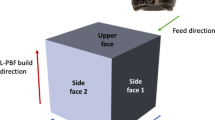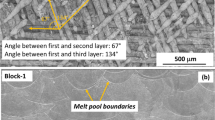Abstract
Selective laser melting(SLM)is an additive manufacturing technology which is suitable for manufacturing metal parts with geometrical complexity and high performance. When geometric accuracy and surface roughness are concerned, it is necessary to carry out a subsequent milling process to obtain desirable characteristics after SLM process. recently, additive/subtractive hybrid machine tools have emerged to harness the merits of SLM process and milling process. However, it is scarce of research covering this kind of hybrid system, and studies are needed to explore the effect of processing parameters on the SLM / dry milling hybrid manufacturing processes. In this paper, 316L stainless steel samples were built by hybrid manufacturing. The effect of laser power (P), scan speed (v), and feed per tooth (fz) on densification level, hardness, chip morphology, and surface roughness was investigated. The highest densification level and average hardness level was obtained with P = 270 W and v = 900 mm/s. The milling operations had an effect on the density and hardness of the samples produced by hybrid manufacturing, and the extent of the effect varied depending upon SLM parameters. The morphology of the chips varied with fz and was influenced by the sample conditions before milling operations. The surface roughness was determined by fz, and the lowest surface roughness level was obtained with fz = 0.02 mm/tooth in the hybrid manufacturing process. Defects on the milled surface was affected by fz and sample conditions concurrently.
























Similar content being viewed by others
Data availability
All data generated or analyzed during this study are included in this published article.
References
Didier P, Piotrowski B, Fischer M, Laheurte P (2017) Mechanical stability of custom-made implants: Numerical study of anatomical device and low elastic Young’s modulus alloy. Mater Sci Eng C 74:399–409
Yan CZ, Liang H, Hussein A, Young P, Raymont D (2014) Advanced lightweight 316L stainless steel cellular lattice structures fabricated via selective laser melting. Mater Des 55:533–541
Brinksmeier E, Levy G, Meyer D, Spierings AB (2020) Surface integrity of selective-laser-melted components. CIRP Ann Manuf Technol 59(1):601–606
Cao S, Zou Y C, Lim C V S, Wu XH (2021) Review of laser powder bed fusion (LPBF) fabricated Ti-6Al-4V: process, post-process treatment, microstructure, and property. Adv Manuf 2(3):313–332
Gupta MK, Singla AK, Ji H, Song Q, Krolczyk GM (2020) Impact of layer rotation on micro-structure, grain size, surface integrity and mechanical behaviour of SLM Al-Si-10Mg alloy. J Market Res 9(5):9506–9522
Yang Y, Xu D, Cao S, Wu S, Huang A (2021) Effect of strain rate and temperature on the deformation behavior in a Ti-23.1Nb-2.0Zr-1.0O titanium alloy. J Mater Sci Technol 73:52–60
Park JM, Jeon JM, Kim JG, Seong Y, Kim HS (2018) Effect of Porosity on Mechanical Anisotropy of 316L Austenitic Stainless Steel Additively Manufactured by Selective Laser Melting. J Korean Powder Metall Inst 25(6):475–481
Bai YC, Zhao CL, Yang J, Hong RC, Weng C, Wang H (2021) Microstructure and machinability of selective laser melted high-strength maraging steel with heat treatment. J Mater Process Technol 288:116906
Cao Q, Bai Y, Zhang J, Shi Z, Fuh J, Wang H (2020) Removability of 316L stainless steel cone and block support structures fabricated by Selective Laser Melting (SLM). Mater Des 191:108691
Zhang KD, Guo XH, Sun L, Meng XF, Xing YQ (2019) Fabrication of coated tool with femtosecond laser pretreatment and its cutting performance in dry machining SLM-produced stainless steel. J Manuf Process 42:28–40
Al-Rubaie KS, Melotti S, Rabelo A, Paiva JM, Elbestawi MA, Veldhuis SC (2020) Machinability of SLM-produced Ti6Al4V titanium alloy parts. J Manuf Process 57:768–786
Campos FDO, Araujo AC, Munhoz ALJ, Kapoor SG (2020) The influence of additive manufacturing on the micromilling machinability of Ti6Al4V: A comparison of SLM and commercial workpieces. J Manuf Process 60:299–307
Didier P, Coz GL, Robin G, Lohmuller P, Piotrowski B, Moufki A, Laheurte P (2021) Consideration of SLM additive manufacturing supports on the stability of flexible structures in finish milling. J Manuf Process 62(2):213–220
Oliveira ARD, Conte EGD (2021) Concurrent improvement of surface roughness and residual stress of as-built and aged additively manufactured maraging steel post-processed by milling. Int J Adv Manuf Technol 116:2309–2323
Zhu Z, Dhokia VG, Nassehi A, Newman ST (2013) A review of hybrid manufacturing processes–state of the art and future perspectives. Int J Comput Integr Manuf 26(7):596–615
Flynn JM, Shokrani A, Newman ST, Dhokia V (2016) Hybrid additive and subtractive machine tools – Research and industrial developments. Int J Mach Tools Manuf 101:79–101
Le VT, Paris H, Mandil G (2018) The development of a strategy for direct part reuse using additive and subtractive manufacturing technologies. Addit Manuf 22:687–699
Priarone PC, Ingarao G (2017) Towards criteria for sustainable process selection: On the modelling of pure subtractive versus additive/subtractive integrated manufacturing approaches. J Clean Prod 144(15):57–68
Choi DS, Lee SH, Shin BS, Whang KH, Song YA, Park SH, Jee HS (2001) Development of a direct metal freeform fabrication technique using CO2 laser welding and milling technology. J Mater Process Technol 113(1):273–279
Joshi A, Anand S (2017) Geometric Complexity Based Process Selection for Hybrid Manufacturing. Procedia Manuf 10:578–589
Wang ZY, Liu RW, Sparks T, Liu H, Frank L (2015) Stereo vision based hybrid manufacturing process for precision metal parts. Precis Eng 42:1–5
Xiong XH, Zhang HO, Wang GL (2009) Metal direct prototyping by using hybrid plasma deposition and milling. J Mater Process Technol 209(1):124–130
Kale AB, Alluri P, Singh AK, Choi SH (2021) The deformation and fracture behavior of 316L SS fabricated by SLM under mini V-bending test. Int J Mech Sci 196:106292
Marnier G, Keller C, Noudem J, Hug E (2014) Functional properties of a spark plasma sintered ultrafine-grained 316L steel. Mater Des 63:633–640
Yang YY, Gong YD, Qu SS, Xie HL, C M, Xu Y C, (2020) Densification, mechanical behaviors, and machining characteristics of 316L stainless steel in hybrid additive/subtractive manufacturing. Int J Adv Manuf Technol 107:177–189
Read N, Wang W, Essa K, Attallah MM (2015) Selective laser melting of AlSi10Mg alloy: Process optimisation and mechanical properties development. Mater Des 65:417–424
Simchi A, Pohl H (2013) Effects of laser sintering processing parameters on the microstructure and densification of iron powder. Mater Sci Eng, A 359:119–128
Cao S, Chen Z, Lim CVS, Yang K, Jia Q, Jarvis T, Tomus D, Wu X (2017) Defect, microstructure, and mechanical property of Ti-6Al-4V alloy fabricated by high-power selective laser melting. JOM 69:2684–2692
Tang C, Le KQ, Wong CH (2020) Physics of humping formation in laser powder bed fusion. Int J Heat Mass Transf 149:119172
Zhou X, Wang DZ, Liu XH, Zhang DD, Qu SL, Ma J, London G, Shen ZJ, Liu W (2010) 3D-imaging of selective laser melting defects in a Co-Cr-Mo alloy by synchrotron radiation micro-CT. Acta Mater 98:1–16
Oliveira JP, Lalonde AD, Ma J (2020) Processing parameters in laser powder bed fusion metal additive manufacturing. Mater Des 193:108762
Kruth JP, Froyen L, Vaerenbergh JV, Mercelis P, Rombouts M, Lauwers M (2004) Selective laser melting of iron-based powder. J Mater Process Technol 149:616–622
Rombouts M, Kruth JP, Froyen L, Mercelis P (2006) Fundamentals of selective laser melting of alloyed steel powders. CIRP Ann Manuf Technol 55(1):187–192
Meier C, Weissbach R, Weinberg J, Wall WA, Hart AJ (2018) Critical influences of particle size and adhesion on the powder layer uniformity in metal additive manufacturing. J Mater Process Technol 266:484–501
Tan JH, Wong W, Dalgarno KW (2017) An overview of powder granulometry on feedstock and part performance in the selective laser melting process. Addit Manuf 18:228–255
Tucho WM, Lysne VH, Austbø H, Kverneland AS, Hansen V (2018) Investigation of effects of process parameters on microstructure and hardness of SLM manufactured SS316L. J Alloy Compd 740:910–925
Yang YY, Gong YD, Qu SS, Xin B, Qi Y (2019) Additive/subtractive hybrid manufacturing of 316L stainless steel powder: Densification, microhardness and residual stress. J Mech Sci Technol 33(12):5797–5807
Yakout M, Elbestawi MA, Veldhuis SC (2019) Density and mechanical properties in selective laser melting of Invar 36 and stainless steel 316L. J Mater Process Technol 266:397–420
Sames WJ, List FA, Pannala S, Dehoff RR, Babu SS (2016) The metallurgy and processing science of metal additive manufacturing. Int Mater Rev 61(5):1–46
Oliveira AR, Jardini AL, Conte EGD (2020) Effects of cutting parameters on roughness and residual stress of maraging steel specimens produced by additive manufacturing. Int J Adv Manuf Technol 111:2449–2459
Casati R, Lemke J, Vedani M (2016) Microstructure and fracture behavior of 316l austenitic stainless steel produced by selective laser melting. J Mater Sci Technol 32(8):738–744
Jawahir IS, Oxley P (1988) The tool restricted contact effect as a major influencing factor in chip breaking: an experimental analysis. CIRP Ann Manuf Technol 37(1):121–126
Maruda RW, Krolczyk GM, Nieslony P, Krolczyk JB, Legutko S (2016) Chip formation zone analysis during the turning of austenitic stainless steel 316L under MQCL cooling condition. Procedia Engineering 149:297–304
Mansour A, Abdalla H (2002) Surface roughness model for end milling: a semi-free cutting carbon casehardening steel (EN32) in dry condition. J Mater Process Technol 124:183–191
Funding
This study was supported by Guangdong Basic and Applied Basic Research Foundation (No.2020B1515120027).
Author information
Authors and Affiliations
Contributions
Chengming Tang designed the experiment, performed the experiment, and was a major contributor in writing the manuscript; Jibin Zhao contributed to the conception of the study; Zhiguo Wang was a major contributor in performing the data analysis; Yuhui Zhao helped perform the data analysis and write the manuscript; Tianran Wang gave constructive discussions. All the authors have read and approved the final manuscript.
Corresponding author
Ethics declarations
Ethics approval
Not applicable.
Consent to participate
Not applicable.
Consent for publication
Not applicable.
Conflict of interest
The authors declare no competing interests.
Additional information
Publisher's Note
Springer Nature remains neutral with regard to jurisdictional claims in published maps and institutional affiliations.
Rights and permissions
About this article
Cite this article
Tang, C., Zhao, J., Wang, Z. et al. Experimental investigation on the effect of process parameters in additive/subtractive hybrid manufacturing 316L stainless steel. Int J Adv Manuf Technol 121, 2461–2481 (2022). https://doi.org/10.1007/s00170-022-09272-3
Received:
Accepted:
Published:
Issue Date:
DOI: https://doi.org/10.1007/s00170-022-09272-3




